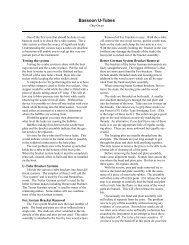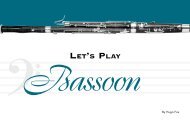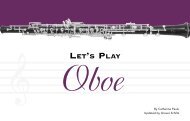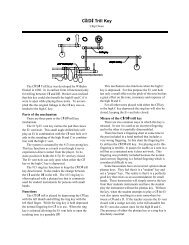Odds and Ends About the Bassoon - Fox Products
Odds and Ends About the Bassoon - Fox Products
Odds and Ends About the Bassoon - Fox Products
Create successful ePaper yourself
Turn your PDF publications into a flip-book with our unique Google optimized e-Paper software.
closed st<strong>and</strong>ing keys. That is, <strong>the</strong> vent hole operated<br />
by <strong>the</strong> key is normally closed until you take an action<br />
that opens it. Only <strong>the</strong> bassoon's whisper key is open<br />
st<strong>and</strong>ing <strong>and</strong> must be closed by <strong>the</strong> action of <strong>the</strong><br />
player.<br />
The real irony in this is that only a few notes on<br />
<strong>the</strong> bassoon really dem<strong>and</strong> that <strong>the</strong> whisper key vent<br />
hole must be open. Anyone who has tried playing<br />
<strong>the</strong>se notes when <strong>the</strong>ir whisper key lock is set knows<br />
about <strong>the</strong>m. The octave d is probably <strong>the</strong> most<br />
dramatic example of <strong>the</strong> problem. Try playing that<br />
note with <strong>the</strong> whisper key closed.<br />
Look at <strong>the</strong> lengths to which we go to close this<br />
key. In addition to <strong>the</strong> normal touch for <strong>the</strong> left<br />
thumb, <strong>the</strong>re are also several varieties of whisper key<br />
locks, alternate whisper keys for <strong>the</strong> left h<strong>and</strong> little<br />
finger <strong>and</strong> for <strong>the</strong> right h<strong>and</strong> thumb <strong>and</strong> even bridges<br />
to close <strong>the</strong> whisper key whenever <strong>the</strong> high A key is<br />
depressed. And don't forget <strong>the</strong> automatic<br />
mechanism that closes <strong>the</strong> whisper key whenever we<br />
depress <strong>the</strong> low E key so that we can have our left<br />
thumb free to play <strong>the</strong> low note keys on <strong>the</strong> bass<br />
joint.<br />
So why do we go to so much trouble to use a<br />
"backwards" key? The reason probably derives from<br />
having always had an open vent hole in <strong>the</strong> bocal.<br />
Whisper keys were developed as devices to close <strong>the</strong><br />
vent, not to open it. That's what we are used to <strong>and</strong><br />
no maker is foolish enough to try to sell us on<br />
changing.<br />
I have known one bassoonist who made a bassoon<br />
for himself with a closed whisper key. George<br />
Jameson was an interesting repair technician who<br />
also made some unusual instruments. I'm sure <strong>the</strong>re<br />
must have been o<strong>the</strong>r bassoons made with closed<br />
whisper keys but George's is <strong>the</strong> only one with which<br />
I have ever actually had any contact.<br />
Knochenhauer Shape:<br />
<strong>Bassoon</strong> reed makers often refer to <strong>the</strong><br />
"Knochenhauer" shape. Shapers designated with a<br />
"K" have been made to shape cane into this famous<br />
shape. The irony of this is that <strong>the</strong>re really is no<br />
single set of dimensions that define what a<br />
Knochenhauer shape really is.<br />
The gentleman who provided <strong>the</strong> name for this<br />
shape was a German reed maker. He was apparently<br />
quite successful in this.<br />
Unlike modern manufacturers of reeds in volume,<br />
Knochenhauer did not make his reeds with a lot of<br />
machinery. Indeed, his reeds were truly "h<strong>and</strong>made."<br />
This extends to shaping. He shaped all of his<br />
cane by h<strong>and</strong>, without <strong>the</strong> benefit of any type of tool<br />
that guided his knife.<br />
ODDS AND ENDS ABOUT THE BASSOON<br />
2<br />
As a result of his h<strong>and</strong> shaping, <strong>the</strong> actual<br />
dimensions of his shaped cane would vary from piece<br />
to piece. Hence, <strong>the</strong>re is no true set of dimensions<br />
that precisely define a Knochenhauer shape.<br />
Today, we tend to depend on a lot of tools that<br />
haven't always been available. Nobody thinks of<br />
h<strong>and</strong> shaping today. Within <strong>the</strong> last generation <strong>the</strong><br />
use of profiling machines has become so common<br />
that <strong>the</strong> skill of h<strong>and</strong> profiling is quickly becoming<br />
lost.<br />
Despite <strong>the</strong> modern need for all of <strong>the</strong>se special<br />
tools, it can all be done by h<strong>and</strong>.<br />
Swabs & U-tubes:<br />
The type of swab we use today is a result of <strong>the</strong><br />
changes in <strong>the</strong> design of <strong>the</strong> u-tube.<br />
Getting <strong>the</strong> bassoon's boot joint properly swabbed<br />
out in <strong>the</strong> vicinity of <strong>the</strong> u-tube can be a problem.<br />
This is a problem that goes back a long way in <strong>the</strong><br />
history of <strong>the</strong> bassoon.<br />
The early bassoons didn't really have a u-tube as<br />
we know it today. Ra<strong>the</strong>r, <strong>the</strong> bottom end of <strong>the</strong> boot<br />
was closed with a cork plug. Behind <strong>the</strong> cork plug a<br />
connection between <strong>the</strong> two bores was carved that<br />
served as <strong>the</strong> u-tube.<br />
The problem with <strong>the</strong> cork plug is that it was not<br />
easily removed, or replaced. This made effective<br />
cleaning of this area of <strong>the</strong> bore very difficult.<br />
Because of <strong>the</strong> difficulties inherent with <strong>the</strong> cork<br />
plug <strong>the</strong> brass u-tube was developed. The earliest of<br />
<strong>the</strong>se were made for ease of removal. The u-tube<br />
itself was mounted on a brass plate that slid into a<br />
dove-tailed fitting. It was certainly easy to remove<br />
<strong>the</strong> u-tube but it was very difficult to get one of <strong>the</strong>se<br />
dove-tailed u-tubes to seal effectively.<br />
The next development was to mount <strong>the</strong> u-tube<br />
using springs that held <strong>the</strong> u-tube plate against <strong>the</strong><br />
bottom of <strong>the</strong> boot joint. This was definitely an<br />
improvement. The u-tube was still easily removed<br />
<strong>and</strong> it did seal better, but not dependably enough.<br />
The modern u-tube is attached to <strong>the</strong> bottom of<br />
<strong>the</strong> boot by means of threaded studs extending from<br />
<strong>the</strong> bottom of <strong>the</strong> boot joint through holes in <strong>the</strong> utube<br />
plate. Tall nuts secure <strong>the</strong> u-tube onto <strong>the</strong>se<br />
studs. The sealing is now effective, but <strong>the</strong> u-tube is<br />
more trouble to remove.<br />
The traditional swabs that have been provided by<br />
most makers, up until recent times, has been a long<br />
straight stick with a lot of wooly material sticking out<br />
of <strong>the</strong> sides along its length. These push swabs are<br />
intended to be pushed into a bore.<br />
A push swab works adequately until it must stop<br />
at an obstacle. The u-tube of a bassoon's boot joint is<br />
such an obstacle.<br />
The advantage of <strong>the</strong> early dove-tailed u-tubes is<br />
that <strong>the</strong> u-tube could be easily removed so that a push








